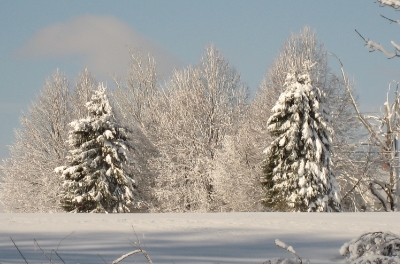Tips for the Perfect Christmas Tree
/The Christmas tree shopping season is underway, and the hunt for that perfect tree has begun. As you start thinking about the choice of your Christmas tree, you won't be alone; according to the National Christmas Tree Association, around 30 million live Christmas trees are sold each year in the United States.
Whether you buy your tree from your favorite charity, a "choose-and-cut" farm, or your local farm stand, here are some ideas on how to make sure it stays fresh, green, and festive through the season.
Shopping: As with anything that we buy that is going to be decorative in the home, there are choices, and everyone has an opinion and a preference. The right tree is the one you like... it's that simple. Beyond that, all you need is to keep in mind some shopping guidelines to ensure that the one you select is a good fit in terms of size and freshness.
Tips for Buying Christmas Trees: Before you bundle up the family and head out on the quest for this year's tree, decide on a location for your tree. Measure both the vertical and horizontal dimensions of the space to make sure the tree will fit. While a highly visible pride of place is always aesthetically the best spot, the tree is best located away from heat sources and shouldn't block entrances or routine household traffic.
Once you have the space measurements in hand and your ideal tree in mind, start shopping with an eye for freshness. Buying from a choose-and-cut tree farm is the best assurance of the freshest tree, but there are plenty of great choices available at other lots too. Do a freshness test by sharply bending a few of a tree's needles with your fingers: except in super-fibrous pine varieties, fresh, green needles will break crisply just like a fresh carrot. It is normal to expect some dry interior needles. Any tree that has excessive needle loss and foliage discoloration, wrinkled bark or a musty odor is not fresh and would not be a great choice. If in doubt, as the vendor what the arrival date of the tree was. If in doubt, move on to another lot.
Christmas tree varieties: Availability, decoration style and family tradition all influence the choice of tree. Here's an overview of the most commonly available varieties.
Balsam fir: The Balsam fir is a long-lasting variety with fairly short, dark-green needles, great form and a pleasant scent.
Colorado blue spruce: The symmetrical form and attractive blue foliage of this variety make it a pleasant holiday addition. Just watch out because the needles can be sharp.
Douglas fir: One of the most popular varieties with short, soft blue-green needles giving off a sweet fragrance when crushed.
Fraser fir: Dark blue-green color, upward-turning branches and a pleasant scent are the hallmarks of the Fraser fir.
Noble fir: The stiff, well-spaced branches of the Noble fir make it a popular choice. It is also commonly used in other decorations such as wreaths and swags.
Scotch pine: The most common of American Christmas trees, the Scotch pine is lush and long-lasting, and its needles won't fall when they're dry.
White pine: This variety has flexible, soft bluish-green needles that are two and a half to five inches long. White pines don't have much of an aroma, and have good needle retention.
White spruce: The best needle retention in the spruce family. The short, stiff needle form give it a great natural shape for easy decorating.
Care and feeding of your Christmas tree: After buying your Christmas tree and getting it home, it's time to decide whether you'll be putting it up right away or waiting for a bit before doing the trimming. If you are going to wait, trim the bottom of the trunk and stand he tree up in a bucket of water. For outdoor storage, choose a shady, and sheltered spot. The tree's first 24 hours at your home are typically its thirstiest, so keep an eye on the water level.
When you're ready to bring your Christmas tree indoors, make sure you've got a stand suited to its dimensions, with a reservoir allowing one quart of water capacity for every inch of the trunk's diameter. Cut another half inch off the bottom of the tree's trunk before placing it in the stand. Make sure the cut is straight across to ensure that it will rest flat in the stand. After placing the tree in the stand, and in it chosen location fill the reservoir with plain tap water. Despite the many ideas of things to add to the water, the leading thinking is that plain water is the best choice. Check the water level daily to make sure the water line is above the trunk's base, and this will keep the tree fresh and lush throughout the holidays.
When its time comes: The season's end will eventually arrive, and you have a chance to do something for the environment. Christmas trees can be easily recycled into nutrient-rich mulch. Most cities and towns have places that accept old tree, and if you're lucky, collection programs. Check your town's website for what they can do.









